Felix Bloch
Felix Bloch | |
|---|---|
 | |
| Born | 23 October 1905 Zürich, Switzerland |
| Died | 10 September 1983 (aged 77) Zürich, Switzerland |
| Nationality | Swiss |
| Citizenship |
|
| Alma mater |
|
| Known for |
|
| Awards |
|
| Scientific career | |
| Fields | Physics |
| Institutions | |
| Doctoral advisor | Werner Heisenberg |
| Doctoral students | Carson D. Jeffries |
Felix Bloch (23 October 1905 – 10 September 1983) was a Swiss-American
Biography

Early life, education, and family
Bloch was born in
Bloch entered public elementary school at the age of six and is said to have been teased, in part because he "spoke Swiss German with a somewhat different accent than most members of the class".
Bloch graduated in 1927, and was encouraged by Debye to go to
On March 14, 1940, Bloch married Lore Clara Misch (1911–1996), a fellow physicist working on X-ray crystallography, whom he had met at an American Physical Society meeting.[6] They had four children, twins George Jacob Bloch and Daniel Arthur Bloch (born January 15, 1941), son Frank Samuel Bloch (born January 16, 1945), and daughter Ruth Hedy Bloch (born September 15, 1949).[5][7]
Career
Bloch remained in European academia, working on superconductivity with
In 1934, the chairman of
During WWII, Bloch briefly worked on the atomic bomb project at Los Alamos. Disliking the military atmosphere of the laboratory and uninterested in the theoretical work there, Bloch left to join the radar project at Harvard University.[9]
After the war, he concentrated on investigations into nuclear induction and nuclear magnetic resonance, which are the underlying principles of MRI.[10][11][12] In 1946 he proposed the Bloch equations which determine the time evolution of nuclear magnetization. He was elected to the United States National Academy of Sciences in 1948.[13] Along with Edward Purcell, Bloch was awarded the 1952 Nobel Prize in Physics for his work on nuclear magnetic induction.
When CERN was being set up in the early 1950s, its founders were searching for someone of stature and international prestige to head the fledgling international laboratory, and in 1954 Professor Bloch became CERN's first director-general,[14] at the time when construction was getting under way on the present Meyrin site and plans for the first machines were being drawn up. After leaving CERN, he returned to Stanford University, where he in 1961 was made Max Stein Professor of Physics.
In 1964, he was elected a foreign member of the Royal Netherlands Academy of Arts and Sciences.[15] He was also a member of the American Academy of Arts and Sciences and the American Philosophical Society.[16][17]
Bloch died in Zürich in 1983.[6]
See also
Footnotes
- doi:10.1063/1.2916128. Archived from the originalon 30 September 2013.
- ^ Sohlman, M (Ed.) Nobel Foundation directory 2003. Vastervik, Sweden: AB CO Ekblad; 2003.
- ISBN 978-0-19-959215-9.
- ^ ISBN 978-0-309-04978-8.
- ^ a b c d e f Hofstadter, Robert; Chodorow, Marvin; Schawlow, Arthur; Walecka, Dirk. "Memorial Resolution: Felix Bloch (1905 - 1983)" (PDF). Archived from the original (PDF) on 11 March 2017. Retrieved 11 November 2017.
- ^ a b Former Fellows of The Royal Society of Edinburgh 1783 – 2002 Archived 19 September 2015 at the Wayback Machine. royalsoced.org.uk
- ^ "Guide to the Felix Bloch Papers".
- ^ "Bloch, Felix", Current Biography, H. W. Wilson Company, 1954. Accessed 24 February 2013. "Because of his Jewish faith, his position soon became uncomfortable and he went to Paris, where he lectured at the Institut Henri Poincaré."
- ^ Charles, Weiner (15 August 1968). "Oral Histories: Felix Bloch". American Institute of Physics. Retrieved 11 November 2017.
- .
- .
- PMID 7643644.
- ^ "Felix Bloch". www.nasonline.org. Retrieved 5 October 2022.
- ^ "People and things : Felix Bloch". CERN Courier. CERN. 1983. Retrieved 1 September 2015.
- ^ "F. Bloch (1905 - 1983)". Royal Netherlands Academy of Arts and Sciences. Retrieved 22 May 2016.
- ^ "Felix Bloch". American Academy of Arts & Sciences. Retrieved 5 October 2022.
- ^ "APS Member History". search.amphilsoc.org. Retrieved 5 October 2022.
References
- "Nobel Prize for Physics, 1952". S2CID 4205574.
- "Deputy Director-General: Prof. E. Amaldi". S2CID 4263821.
- McGraw-Hill Modern Men of Science. Vol. 1. ISBN 978-0-07-045217-6.
- National Cyclopaedia of American Biography. Vol. 61. ISBN 0-88371-040-4.
Further reading
External links
 Media related to Felix Bloch at Wikimedia Commons
Media related to Felix Bloch at Wikimedia Commons
- Felix Bloch on Nobelprize.org
- Oral History interview transcript with Felix Bloch on 14 May 1964, American Institute of Physics, Niels Bohr Library and Archives - interview conducted by Thomas S. Kuhn in Palo Alto, California
- Oral History interview transcript with Felix Bloch on 15 August 1968, American Institute of Physics, Niels Bohr Library and Archives - interview conducted by Charles Weiner at Stanford University
- Oral History interview transcript with Felix Bloch 15 December 1981, American Institute of Physics, Niels Bohr Library and Archives - interview conducted by Lillian Hoddeson at Stanford University
- Felix Bloch Papers, 1931–1987 (33 linear ft.) are housed in the Department of Special Collections and University Archives at Stanford University Libraries
- National Academy of Sciences Biographical Memoir
- Felix Bloch Papers
